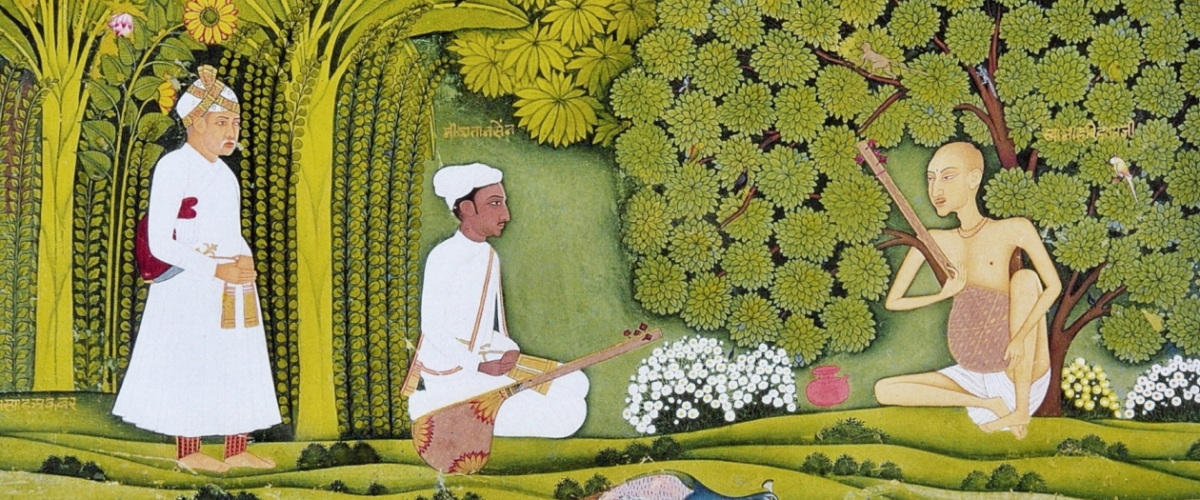

Swami Haridas, a mystic-musician and renowned guru of the early 16th century, is thought to have had an innate knowledge of classical music gained through numerous spiritual and devotional practices. Born around 1480, he became an ascetic at an early age he moved to Vrindavan, the legendary forest of Lord Krishna, where he devoted himself to yoga and music.
He is credited with a large body of Dhrupad compositions, which not only had a major impact on classical music but also influenced the Bhakti devotional cult, particularly including devotees of Lord Krishna and his consort Radha.
Though details of his life are sparse (and mostly preserved through oral traditions), Haridas also gives his name to a spiritual movement known as Haridasi which still has a sizeable following in North India. His compositions gained such widespread popularity that immensely gifted musicians from every part of India sought to go into pupillage with the reclusive master.
Tansen (born c.1508) was one such sudent. Probably North India’s greatest and most famous musical figure, he eventually became one of the navratan (‘nine jewels’) at the court of the Mughal Emperor Akbar (r.1542-1605). Tansen was sent to Vrindavan where he remained with Swami Haridas for a decade before becoming court musician at Gwalior, followed by musical patronage from Raja Ram Singh at Rewa.
During this time, Tansen continued experimenting with sound and composing a vast repertoire of dhrupads and although a Muslim, many of his songs were in praise of Hindu deities. He was primarily a beenkar (veena player), but his vocal abilities were said to be outstanding, helping strengthen the links between veena and dhrupad.
There are numerous stories about his powers as a singer - when he sang the springtime Raag Bahari, plants would begin to flower; with Raag Megh Malhar, clouds would start forming and burst into rain; and with Raag Deepak (‘flame’) fires would break out and oil lamps would light up spontaneously.
It was on hearing such stories that Emperor Akbar is said to have sought Tansen for his court and, by making him one of the nine jewels of the Mughal Empire, conferred upon him not only the status of the most elevated musician in the land but also one who was also highly influential in political, diplomatic and judicial matters.
Although the details of Tansen’s early years are often unclear, and his legendary status often overshadows fact, his presence at Akbar’s court resulted in his subsequent musical life being meticulously documented by Akbar’s diarist, Abul-Fazl. Akbar conferred the affectionate title of Miyan (meaning a young man of some standing) upon Tansen, although some sources claim he earned this title whilst at Gwalior.
Tansen went on to compose some of the best-known raags performed today: Miyan ki Malhar (ki meaning ‘of’ or ‘pertaining to), Miyan ki Sarang and Miyan ki Todi and the majestic Darbari, dedicated to the Emperor.
The Senia gharana tradition, named after Tansen, exists to this day, and countless musicians claim to be direct descendants of the great man. In addition to the compositions and legendary performances, musicologists revere Tansen as Indian music's greatest codifier because, at that time there were thousands of raags – many overlapping, with a maze of confusing names – which Tansen analysed in great detail, reducing them to the five hundred or so that for the basis of today's music.
Despite Tansen’s greatness, legend has it that he was was challenged by, and lost to, another pupil of Swami Haridas, an outstanding musician of the time nicknamed Baiju Bawra (bawra meaning ‘crazy’). A dhrupad singer, he had also been a court musician at Gwalior. but his early life is not easily verifiable despite a sizeable body of folklore about his vocal prowess. To further complicate matters, there appear to be two great musicians known as Baiju, separated by some 300 years, only one of whom could have been Tansen’s contemporary.
An Indian film, Baiju Bawra (released in 1952), gets some very good, though largely fictionalised, dramatic mileage from the famous Tansen-Baiju singing contest. In real life, both Abul Fazl and later Mughal historians have recorded that Tansen touched Baiju’s feet to acknowledge his victory, but Baiju, perhaps the greater musician, is said to have withdrawn into obscurity, leaving Tansen unencumbered to bask in his larger-than-life status.
Listen to the music | Sitar maestro Pandit Budhaditya Mukherjee’s spectacular mid-thunderstorm rendition of the rain-bringing Miyan Ki Malhar, a raag said to have been written by Tansen.
Jameela Siddiqi is an author, linguist, and BBC cultural commentator, specialising in postcolonial fiction and the devotional music of South Asia.
Darbar believes in the power of Indian classical music to stir, thrill, and inspire. Explore our YouTube channel, or subscribe to the Darbar Concert Hall to watch extended festival performances, talk and documentaries in pristine HD and UHD quality.
The conventions of concert etiquette for Western classical music are a little daunting. Don't breathe heavily. Don't...
Read More 
The santoor is an ancient folk instrument thought to have originated in Persia, from where, according to some...
Read More 
This longform piece into the depths of Darbar's origins represents the vibrant life history of the man behind it all.
Read More 
The beginner's guide to Indian classical music. Whether you’re completely new to raga music or just need a refresher, we’ve put together this brief overview of all things raga music to help you feel at ease when visiting one of our concerts or watch our videos on our YouTube or our Darbar Concert Hall.
Keep up to date with the latest news, events, music and musings across our social channels
For hundreds more clips and shorts, vist our YT page here 